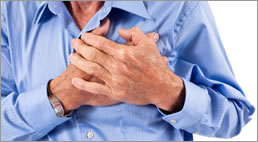Good, Bad, and Badder Cholesterol?
Dr. Jay Kenney, our nutrition research specialist, discusses compelling new data on what is likely a new type of bad cholesterol – a silent but deadly type. He also explains how to combat it. Don’t miss this story. It’s all about giving yourself the best protection against a heart attack.
Dr. Jay Kenney, our nutrition research specialist, discusses compelling new data on what is likely a new type of bad cholesterol – a silent but deadly type. He also explains how to combat it. Don’t miss this story. It’s all about giving yourself the best protection against a heart attack.

by James J. Kenney, PhD, FACN
Nutrition Research Specialist, Pritikin Longevity Center
If elevated levels of LDL (the so-called “bad” cholesterol) were the only source of cholesterol deposited in the artery wall, high doses of potent statins should not only reduce but also reverse the build-up of atherosclerotic plaques and largely eliminate deaths from coronary heart disease.
But sadly, the #1 cause of death in Americans taking statins to lower their elevated LDL levels to prevent heart attacks is still heart attacks.
Yes, statin drugs are very effective for reducing high LDL levels, and they do slow the progression of cholesterol-filled plaques, but they rarely reverse the build-up of cholesterol in the artery wall. More importantly, statin drugs alone do not come close to eliminating the risk of heart attacks and most strokes despite impressive reductions in LDL levels.
Cholesterol remnants: VLDL, chylomicrons
A growing body of research is now showing that there are lipoproteins (proteins that transfer cholesterol throughout the body) in addition to LDL particles that can and do carry cholesterol from the blood into the artery wall and promote the growth of cholesterol-filled plaques and coronary artery disease. These lipoproteins are neither LDL nor HDL. Rather, they consist of the cholesterol-rich remnants of triglyceride-rich lipoproteins. One of these remnants, VLDL, is produced by the liver. Another, chylomicrons, is produced by the small intestine.1
Both genetic and dietary factors influence the amount of triglyceride-rich lipoproteins we produce, and also the amount of cholesterol-rich remnant particles derived from each of them in the blood.
But it is important to point out that science has found that fat- and cholesterol-rich meals can dramatically increase the production of chylomicrons and lead to greater amounts of cholesterol-rich chlyomicron remnants in the blood for several hours after each fat-rich meal.2
Silent but deadly cholesterol
I like to refer to these remnants as “silent but deadly” cholesterol because 1), few people know about them; and 2), by the time we have a fasting blood test, their dirty work is done and they’re gone, and therefore undetected by the standard fasting blood lipid test.
Nearly triple the risk of heart problems
In a recently published study, Dr. Borge Nordestgaard at the University of Copenhagen demonstrated just how dangerous these silent-but-deadly cholesterol remnants can be. He and colleagues followed nearly 12,000 people in Denmark who had established coronary heart disease, diagnosed between 1976 and 2010. The scientists found that each 1 mmol (38.7mg/dl) increase in nonfasting remnant cholesterol caused 2.8 times greater risk of a coronary heart disease event that was independent of HDL levels. The increased causal risk of heart disease from elevated cholesterol remnant particles appeared much stronger than for changes in either LDL or HDL levels.3
Unfortunately, these cholesterol remnants will continue to be silent but deadly for many of us. That’s because most physicians still order only fasting blood lipids, and they focus largely on LDL and HDL levels to assess their patient’s future heart disease risk.
Even advanced lipid tests now available clinically focus mostly on the number and/or size of LDL and HDL particles. This practice is based on what scientists are now realizing are simplistic notions, namely, that only LDL particles deliver cholesterol to the artery wall, making LDL the one and only “bad” cholesterol, and that HDL particles are always “good” because they remove cholesterol from the artery wall and ferry it back to the liver.
When good cholesterol goes bad
We now know that HDL particles can actually become pro-inflammatory and pro-atherogenic “bad” HDL particles, perhaps partially in response to biochemical changes in HDL triggered in part by chylomicrons and other remnant cholesterol particles in the blood.
Cholesterol-rich remnants
Chylomicrons and their cholesterol-rich remnants remain in the blood for several hours after each fat-rich meal and likely play a major role in promoting atherosclerosis not only by delivering more cholesterol-rich remnant particles into the artery wall but also by inciting inflammation (increasing IL-6 and C-reactive protein) and clotting of the blood, or thrombosis (activating clotting factor VII).
Also, damage to the endothelium (the inside “skin” of the artery wall), as evidenced by research documenting reduced flow-mediated dilation (reduced ability of the arteries to open up to let blood flow through), occurs to a much greater extent after a single fat-rich meal than after a meal high in carbohydrate. This research points to pathological changes that must be occurring in the artery wall in response to fat- and cholesterol- rich particles coming from the intestines.4
Indeed, this reduced flow-mediated dilation is likely the main reason why many people with angina tend to experience far more chest pain after a large fat-rich meal than they do after a meal high in carbohydrate-rich plant foods.
“Bad” Cholesterol and “Badder”
The only legitimate debate, then, is not whether LDL or other cholesterol-rich remnant particles promote atherosclerosis, but which is more atherogenic. Clearly, both LDL and other remnant lipoprotein particles deliver cholesterol to the artery wall and promote foam cell (fatty streak) formation and atherosclerosis. But unlike LDL particles, which must first be oxidized, studies have documented that remnant cholesterol particles are readily taken up by scavenger receptors of macrophages (large white blood cells) in the artery wall to form foam cells.5,6
Increasing evidence suggests that damage to the artery wall from cholesterol-rich remnant particles appears to be at least as important as either fasting LDL or HDL levels for predicting future coronary heart disease events.
Type 2 diabetes
It should be noted that diets high in refined carbohydrates (particularly large amounts of refined sugars) combined with inactivity can contribute to a marked increase in the liver’s production of VLDL particles because the liver converts some of the excess carbohydrate (especially fructose) into triglyceride. This leads to more triglyceride-rich VLDL particles being released into the blood, which then degrade into cholesterol-rich remnant particles and eventually also LDL particles. This is particularly true in people who are genetically prone to develop insulin resistance and type 2 diabetes and experience significant increases in fasting triglyceride levels as visceral fat stores in the body accumulate.
Visceral fat is the fat that surrounds the vital organs in the stomach area. It is not the fat that lies just under your skin, which is called subcutaneous fat. Visceral fat is also known as the dangerous fat because the more you carry around, the higher your risk of diabetes, heart disease, and other metabolic disorders.
Bottom Line…
To prevent heart attacks, strokes, and other cardiovascular diseases, reducing LDL bad cholesterol is vital, and statin drugs are often very effective at lowering LDL.
But there are many factors in addition to high LDL that mess up our arteries, and most are diet/lifestyle related, including high blood pressure, high blood sugar, excess weight, smoking, high triglyceride levels, and now, we’re learning, cholesterol remnants like VLDL and chylomicrons.
Statins do not eliminate any of these artery killers.
That is why reducing LDL levels with statin drugs alone is generally insufficient for stopping and reversing cardiovascular disease and preventing most heart attacks and strokes. The fact is, the #1 cause of death in Americans taking statins to prevent heart attacks is still heart attacks.
The good news is there is an approach that attacks virtually all lifestyle-related factors that lead to heart attacks, and that approach is a much healthier lifestyle, like the Pritikin Program. When you exercise daily and eat well – an abundance of whole foods like fruits, vegetables, and whole grains, and very little salt, fat, sugar, and refined (“white”) carbohydrates – the following benefits happen, demonstrated in more than 100 peer-reviewed studies on the Pritikin Program:
- Decreased LDL bad cholesterol levels, and
- Decreased blood pressure
- Decreased blood glucose (sugar) and insulin levels
- Loss of excess body fat
- Decreased levels of inflammatory factors
- Decreased fasting and postprandial (post meal) triglyceride levels, generally associated with decreased cholesterol remnants
A very healthy diet and lifestyle, in short, can help you fight heart disease on all fronts. It can not only slow the progression of the disease and reduce the risk of heart attacks but also help reverse atherosclerosis and largely eliminate the risk of heart attacks.
If your doctor recommend statins, by all means take them. But don’t stop there. Ramp up your chances of living free of heart problems with healthy living. In addition to the many proven benefits of a Pritikin lifestyle, another likely benefit is major reductions in remnant cholesterol levels in the blood, which growing research suggests could yield major reductions in coronary artery disease and heart attacks.

Health Alert: High Triglycerides
We know that high cholesterol leads to heart attacks, but few of us know that high triglycerides are troublemakers, and that 1 in 2 Americans have high triglycerides.
Author, Dr. James J. (Jay) Kenney, PhD, RD, FACN
1 Nordestgaard BG, Freiberg JJ. Clinical relevance of non-fasting and postprandial hypertriglyceridemia and remnant cholesterol. Curr Vasc Pharm. 2011; 9 (3): 281-6.
2 Cesar TB, et al. High cholesterol intake modifies chylomicron metabolism in normolipidemic young men. J Nutr. 2006; 136: 971-6.
3 Varbo A, et al. Remnant cholesterol as a causal risk factor for ischemic heart disease. J Am Col Cardiol. 2013; 61 (4): 427-36.
4 Tomaino RM, Decker EA. High-fat meals and endothelial function. Nutr Rev. 1998; 56 (6): 182-5.
5 Zilversmit DB. A proposal linking atherogenesis to the interaction of endothelial lipoprotein and triglyceride-rich lipoproteins. Circ Res.1973; 33: 633-8.
6 Nakajima K, Nakano T, Tanaka A. The oxidative modification hypothesis of atherosclerosis: The comparison of atherogenic effects on oxidized LDL and remnant lipoproteins in plasma. Clin Chim Acta. 2006; 367: 36-47.